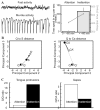Behavioral modulation of gustatory cortical activity
- PMID: 19686167
- PMCID: PMC2845300
- DOI: 10.1111/j.1749-6632.2009.03922.x
Behavioral modulation of gustatory cortical activity
Abstract
Our perception of the sensory world is constantly modulated by the environment surrounding us and by our psychological state; each encounter with the same stimulus can in fact evoke very different perceptions. This phenomenological richness correlates well with the plasticity and the state-dependency observed in neural responses to sensory stimuli. This article reviews recent results on how the processing of sensory inputs varies depending on the internal state of the animal. Specifically it focuses on the gustatory system and on data showing that levels of attention and expectation modulate taste processing and gustatory cortical activity in meaningful ways. Mounting experimental evidence suggesting that expectation-dependent changes in gustatory cortical activity result from changes in the coupling between the amygdala and the cortex will also be discussed. The results presented here begin to paint a complex picture of taste, which goes beyond the framework of classical coding theories.
Conflict of interest statement
The authors declare no conflicts of interest.
Figures

Similar articles
-
State Dependency of Chemosensory Coding in the Gustatory Thalamus (VPMpc) of Alert Rats.J Neurosci. 2015 Nov 25;35(47):15479-91. doi: 10.1523/JNEUROSCI.0839-15.2015. J Neurosci. 2015. PMID: 26609147 Free PMC article.
-
Expectation-induced modulation of metastable activity underlies faster coding of sensory stimuli.Nat Neurosci. 2019 May;22(5):787-796. doi: 10.1038/s41593-019-0364-9. Epub 2019 Apr 1. Nat Neurosci. 2019. PMID: 30936557 Free PMC article.
-
Associative learning changes cross-modal representations in the gustatory cortex.Elife. 2016 Aug 30;5:e16420. doi: 10.7554/eLife.16420. Elife. 2016. PMID: 27572258 Free PMC article.
-
Gustatory processing: a dynamic systems approach.Curr Opin Neurobiol. 2006 Aug;16(4):420-8. doi: 10.1016/j.conb.2006.06.011. Epub 2006 Jul 13. Curr Opin Neurobiol. 2006. PMID: 16842991 Review.
-
Neural Ensemble Recordings from Central Gustatory-Reward Pathways in Awake and Behaving Animals.In: Nicolelis MAL, editor. Methods for Neural Ensemble Recordings. 2nd edition. Boca Raton (FL): CRC Press/Taylor & Francis; 2008. Chapter 10. In: Nicolelis MAL, editor. Methods for Neural Ensemble Recordings. 2nd edition. Boca Raton (FL): CRC Press/Taylor & Francis; 2008. Chapter 10. PMID: 21204447 Free Books & Documents. Review.
Cited by
-
Oscillations Trumped by Behavior: A Link between Sensory and Direct Electrical Stimulation of Cortical Activity.Front Neurosci. 2010 Sep 15;4:39. doi: 10.3389/fnins.2010.00039. eCollection 2010. Front Neurosci. 2010. PMID: 20859523 Free PMC article. No abstract available.
-
Orosensory and Homeostatic Functions of the Insular Taste Cortex.Chemosens Percept. 2012 Mar 1;5(1):64-79. doi: 10.1007/s12078-012-9117-9. Chemosens Percept. 2012. PMID: 25485032 Free PMC article.
-
Toward a Wiring Diagram Understanding of Appetite Control.Neuron. 2017 Aug 16;95(4):757-778. doi: 10.1016/j.neuron.2017.06.014. Neuron. 2017. PMID: 28817798 Free PMC article. Review.
-
The anterior insular cortex represents breaches of taste identity expectation.J Neurosci. 2011 Oct 12;31(41):14735-44. doi: 10.1523/JNEUROSCI.1502-11.2011. J Neurosci. 2011. PMID: 21994389 Free PMC article.
-
Activity of Insula to Basolateral Amygdala Projecting Neurons is Necessary and Sufficient for Taste Valence Representation.J Neurosci. 2019 Nov 20;39(47):9369-9382. doi: 10.1523/JNEUROSCI.0752-19.2019. Epub 2019 Oct 9. J Neurosci. 2019. PMID: 31597726 Free PMC article.
References
-
- Fontanini A, Katz DB. 7 to 12 Hz activity in rat gustatory cortex reflects disengagement from a fluid self-administration task. J Neurophysiol. 2005;93:2832–2840. - PubMed
-
- Fontanini A, Katz DB. State-dependent modulation of time-varying gustatory responses. J Neurophysiol. 2006;96:3183–3193. - PubMed
-
- Berridge KC. Measuring hedonic impact in animals and infants: microstructure of affective taste reactivity patterns. Neurosci Biobehav Rev. 2000;24:173–198. - PubMed
-
- Grill HJ, Norgren R. The taste reactivity test. I. Mimetic responses to gustatory stimuli in neurologically normal rats. Brain Res. 1978;143:263–279. - PubMed
Publication types
MeSH terms
Grants and funding
LinkOut - more resources
Full Text Sources
Medical

